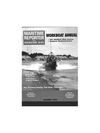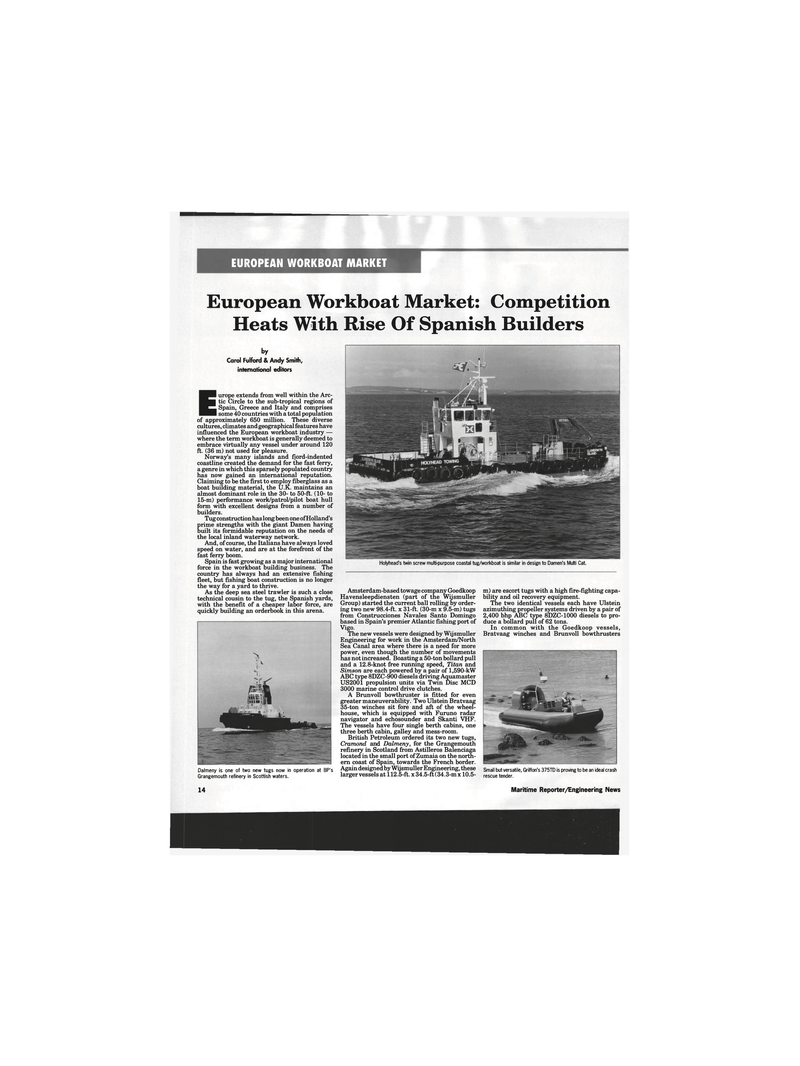
Page 12: of Maritime Reporter Magazine (October 1994)
Read this page in Pdf, Flash or Html5 edition of October 1994 Maritime Reporter Magazine
EUROPEAN WORKBOAT MARKET
European Workboat Market: Competition
Heats With Rise Of Spanish Builders by
Carol Fulford & Andy Smith, international editors
Europe extends from well within the Arc-tic Circle to the sub-tropical regions of Spain, Greece and Italy and comprises some 40 countries with a total population of approximately 650 million. These diverse cultures, climates and geographical features have influenced the European workboat industry — where the term workboat is generally deemed to embrace virtually any vessel under around 120 ft. (36 m) not used for pleasure.
Norway's many islands and fjord-indented coastline created the demand for the fast ferry, a genre in which this sparsely populated country has now gained an international reputation.
Claiming to be the first to employ fiberglass as a boat building material, the U.K. maintains an almost dominant role in the 30- to 50-ft. (10- to 15-m) performance work/patrol/pilot boat hull form with excellent designs from a number of builders.
Tug construction has long been one of Holland's prime strengths with the giant Damen having built its formidable reputation on the needs of the local inland waterway network.
And, of course, the Italians have always loved speed on water, and are at the forefront of the fast ferry boom.
Spain is fast growing as a major international force in the workboat building business. The country has always had an extensive fishing fleet, but fishing boat construction is no longer the way for a yard to thrive.
As the deep sea steel trawler is such a close technical cousin to the tug, the Spanish yards, with the benefit of a cheaper labor force, are quickly building an orderbook in this arena.
DaImeny is one of two new tugs now in operation at BP's
Grangemouth refinery in Scottish waters.
Holyhead's twin screw multi-purpose coastal tug/workboat is similar in design to Damen's Multi Cat.
Amsterdam-based towage company Goedkoop
Havensleepdiensten (part of the Wijsmuller
Group) started the current ball rolling by order- ing two new 98.4-ft. x 31-ft. (30-m x 9.5-m) tugs from Construcciones Navales Santo Domingo based in Spain's premier Atlantic fishing port of
Vigo.
The new vessels were designed by Wijsmuller
Engineering for work in the Amsterdam/North
Sea Canal area where there is a need for more power, even though the number of movements has not increased. Boasting a 50-ton bollard pull and a 12.8-knot free running speed, Titan and
Simson are each powered by a pair of 1,590-kW
ABC type 8DZC-900 diesels driving Aquamaster
US2001 propulsion units via Twin Disc MCD 3000 marine control drive clutches.
A Brunvoll bowthruster is fitted for even greater maneuverability. Two Ulstein Bratvaag 35-ton winches sit fore and aft of the wheel- house, which is equipped with Furuno radar navigator and echosounder and Skanti VHF.
The vessels have four single berth cabins, one three berth cabin, galley and mess-room.
British Petroleum ordered its two new tugs,
Cramond and Dalmeny, for the Grangemouth refinery in Scotland from Astilleros Balenciaga located in the small port of Zumaia on the north- ern coast of Spain, towards the French border.
Again designed by Wijsmuller Engineering, these larger vessels at 112.5-ft. x34.5-ft(34.3-mxl0.5- m) are escort tugs with a high fire-fighting capa- bility and oil recovery equipment.
The two identical vessels each have Ulstein azimuthing propeller systems driven by a pair of 2,400 bhp ABC type 8DZC-1000 diesels to pro- duce a bollard pull of 62 tons.
In common with the Goedkoop vessels,
Bratvaag winches and Brunvoll bowthrusters
Small but versatile, Griffon's 375TD is proving to be an ideal crash rescue tender. 14 Maritime Reporter/Engineering News

 11
11

 13
13
